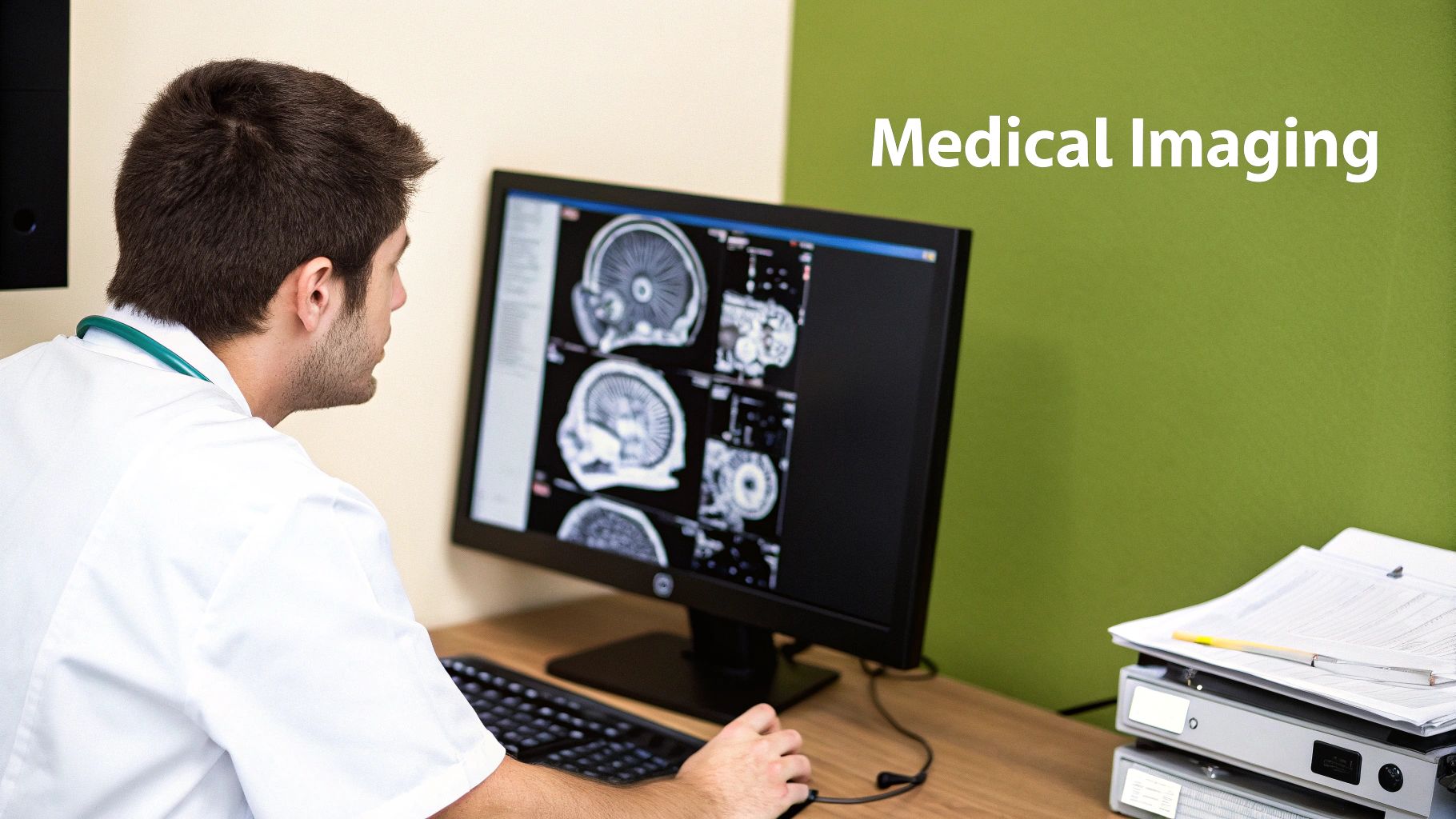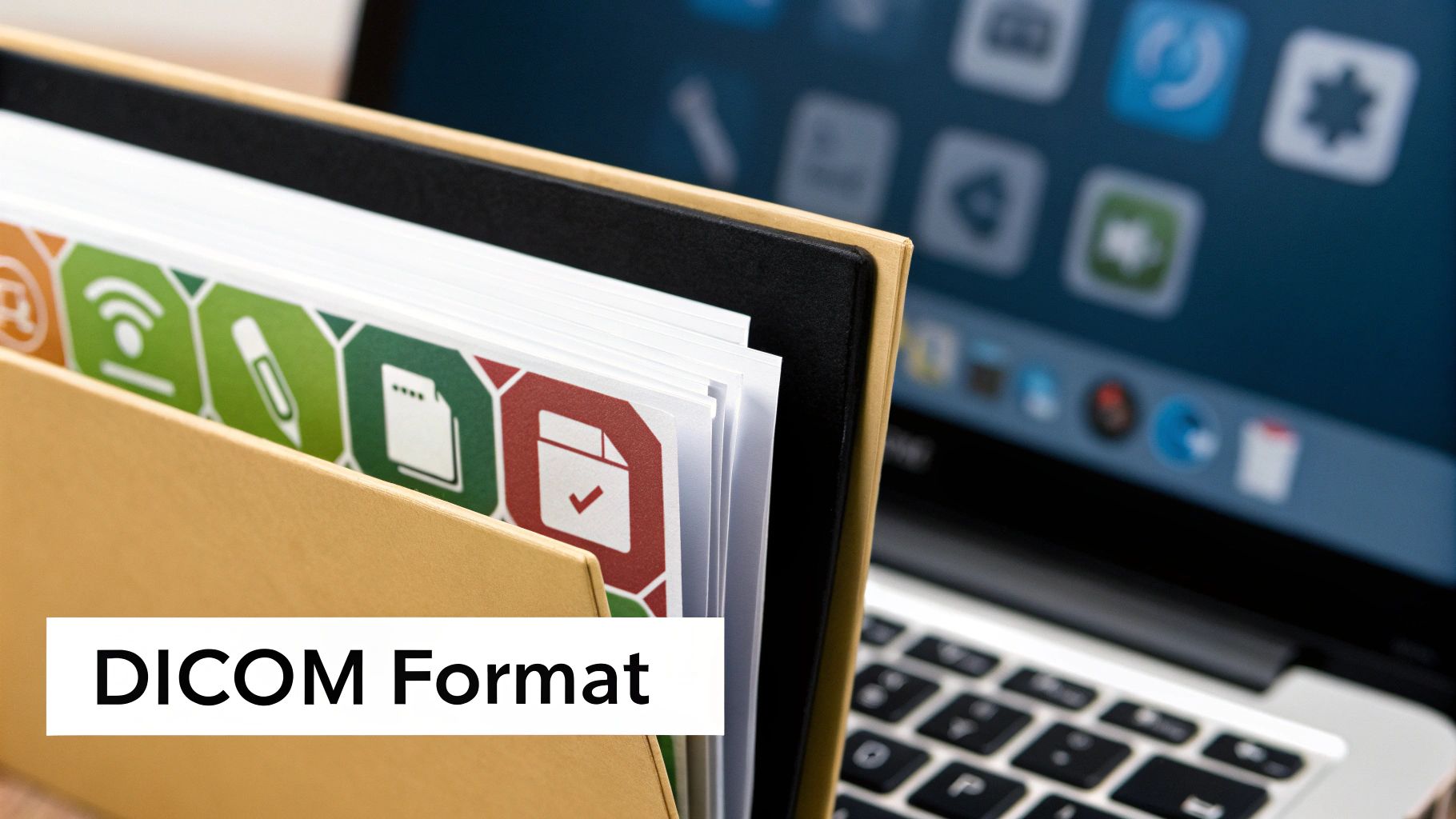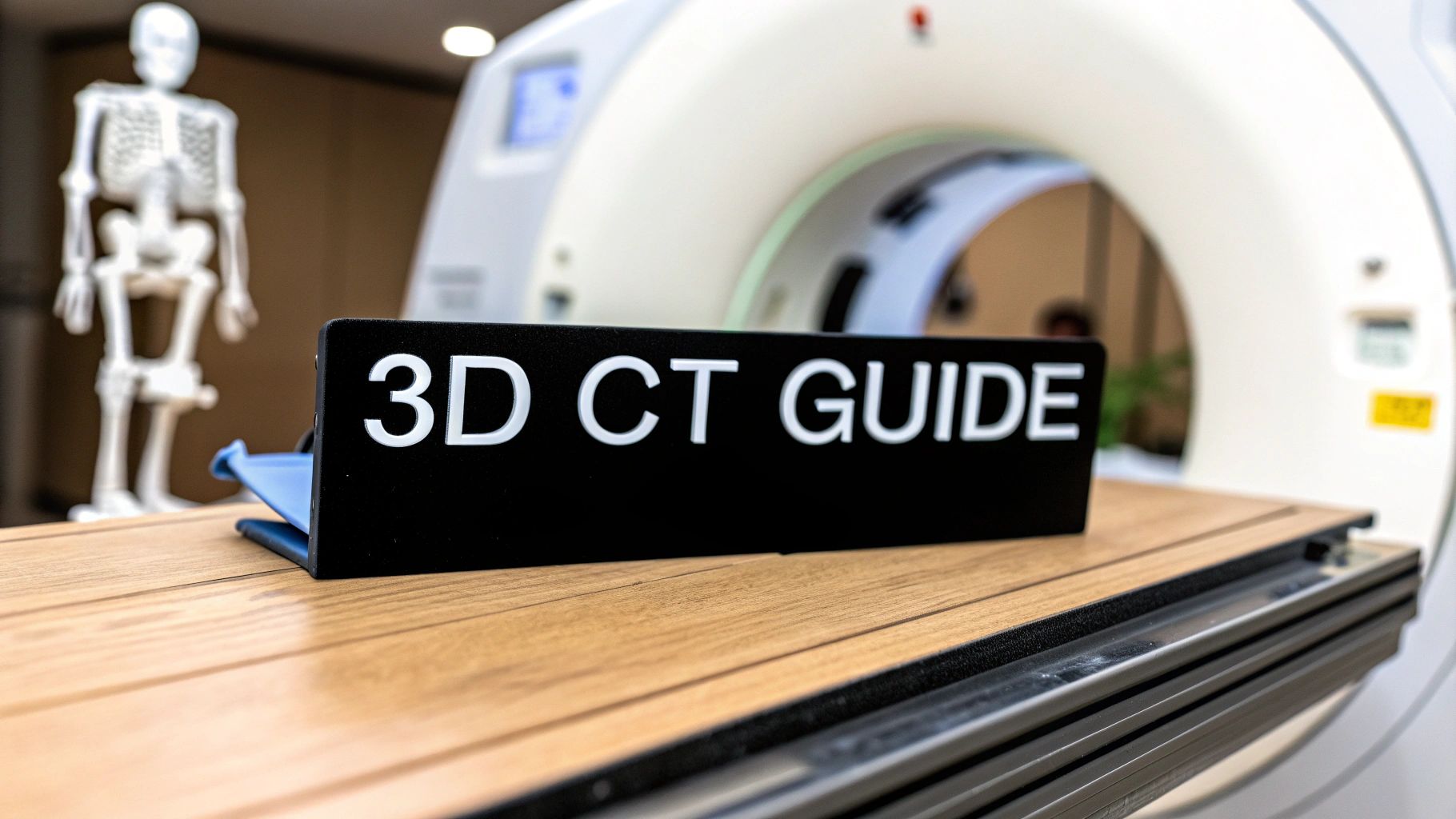Understanding DICOM To NIfTI Conversion Fundamentals

In medical imaging, two key file formats stand out: DICOM (Digital Imaging and Communications in Medicine) and NIfTI (Neuroimaging Informatics Technology Initiative). DICOM is the established standard for storing and sharing medical images. Its strength lies in its rich metadata, encompassing patient details, acquisition parameters, and other vital information. However, this complexity can hinder image analysis, particularly in neuroimaging research.
This is where NIfTI enters the picture. Designed specifically for neuroimaging, NIfTI offers a simpler, more efficient structure ideal for analysis. Consider this analogy: DICOM is a comprehensive encyclopedia containing every detail about an image, while NIfTI is a focused summary perfect for swift processing. This structural difference leads to significant gains in analysis speed and compatibility with neuroimaging software. As a result, converting DICOM to NIfTI is now a cornerstone of many research and clinical workflows.
Why Convert?
The main driver behind DICOM to NIfTI conversion is the demands of neuroimaging analysis. Many specialized tools and software packages, like those found in 3D Slicer, are built to work primarily with NIfTI. Moreover, conversion often leads to smaller file sizes, optimizing data management and processing. For instance, a large DICOM dataset with multiple series can be transformed into a single, easier-to-manage NIfTI file.
The conversion process has become a vital step in neuroimaging research, simplifying analysis and visualization of medical imaging data. Its importance grew significantly around 2016, when it was recognized as a crucial initial step in neuroimaging data processing due to DICOM's complexity compared to NIfTI's streamlined format. Learn more about this process here.
When Is Conversion Necessary?
DICOM to NIfTI conversion is essential when working with neuroimaging data intended for analysis using specialized software. This includes applications like brain mapping, fMRI studies, and structural MRI analysis. It's not always a requirement, however. If your primary goal is image viewing or patient data storage, using DICOM might suffice. Understanding the specific needs of your workflow is key to determining whether conversion is needed.
Benefits of Conversion
Converting to NIfTI unlocks several practical advantages:
- Improved Compatibility: NIfTI files are widely compatible with neuroimaging analysis tools.
- Simplified Analysis: NIfTI's simpler structure enables faster processing and easier data manipulation.
- Reduced Storage: NIfTI files generally require less storage space than their DICOM counterparts.
- Streamlined Workflows: Conversion fits seamlessly into numerous existing neuroimaging pipelines.
These combined benefits promote more efficient research and clinical workflows, allowing professionals to focus on analysis rather than data preparation. This emphasis on efficiency is vital for managing the growing volumes of data in modern medical imaging.
Essential Tools For DICOM To NIfTI Conversion Success
Choosing the right DICOM to NIfTI conversion tool is crucial for efficient workflows and reliable results. This section explores several popular options, highlighting why dcm2niix has become the industry standard.
Key Features To Consider
Selecting the right converter requires careful consideration of essential features:
-
Metadata Preservation: Maintaining accurate metadata, such as patient demographics and acquisition parameters, is crucial for research integrity.
-
BIDS Compatibility: Compatibility with the Brain Imaging Data Structure (BIDS) standard simplifies data organization and sharing. This includes generating BIDS-compliant NIfTI files and JSON sidecars.
-
DICOM Standard Adherence: The tool should seamlessly handle diverse DICOM transfer syntaxes and image modalities.
-
Error Handling and Reporting: Clear error messages and detailed reports simplify troubleshooting.
-
Batch Processing: Efficiently handling large datasets requires the ability to process multiple DICOM files simultaneously.
-
User-Friendliness: An intuitive interface and comprehensive documentation are essential, especially for new users.
Top Conversion Tools
Several tools are commonly used for DICOM to NIfTI conversion:
-
dcm2niix: This command-line tool is a mainstay in neuroimaging, known for its robust features and active community support. Its cross-platform compatibility (macOS, Linux, Windows) and support for BIDS and various DICOM formats make it widely popular. Read the full research here
-
MRIcroGL: This tool provides a user-friendly graphical interface and integrates dcm2niix for its conversion capabilities.
-
3D Slicer: Primarily a medical image visualization and analysis platform, 3D Slicer also includes DICOM to NIfTI conversion functionality.
-
Other Libraries and Tools: Python libraries like nibabel and pydicom offer programmatic conversion for users requiring greater control and customization.
To stay updated on the latest AI tools and information in general, the aitoolsbrief blog provides helpful resources.

The following table provides a comparison of some popular DICOM to NIfTI conversion tools.
Popular DICOM To NIfTI Conversion Tools Comparison
Comprehensive comparison of leading conversion tools including features, platform support, and performance metrics
| Tool Name | Platform Support | Key Features | Performance | Community Support |
|---|---|---|---|---|
| dcm2niix | macOS, Linux, Windows | BIDS support, diverse DICOM format handling, command-line interface | High performance, efficient batch processing | Active community, extensive documentation |
| MRIcroGL | macOS, Linux, Windows | User-friendly GUI, integrates dcm2niix | Good performance, relies on dcm2niix | Active community |
| 3D Slicer | Cross-platform | Integrated within a larger image processing suite | Performance dependent on overall system resources | Large user base, comprehensive documentation |
| nibabel (Python) | Cross-platform | Programmatic control, flexible customization | Performance dependent on implementation | Active Python community |
| pydicom (Python) | Cross-platform | Programmatic access to DICOM data | Performance dependent on implementation | Active Python community |
Key insights from the table include the strengths of dcm2niix in terms of performance and BIDS compatibility, the user-friendliness of MRIcroGL, and the flexibility offered by Python libraries.
Choosing The Right Tool
The "best" tool depends on individual needs and technical skills. dcm2niix offers power and flexibility. MRIcroGL prioritizes ease of use. 3D Slicer is a good choice for users already working within its environment. Python libraries cater to those needing advanced customization.
Installation and System Compatibility
Most tools are accessible via package managers or direct downloads. Ensuring compatibility with your operating system and any required dependencies is important. dcm2niix, for example, offers pre-compiled binaries for various platforms.
Troubleshooting
Conversion issues can sometimes occur. Common problems include incorrect file paths, missing metadata, or format incompatibility. Checking file integrity, verifying dependencies, and consulting community forums or documentation can help resolve these challenges. Proactive troubleshooting ensures efficient DICOM to NIfTI conversion workflows.
Step-By-Step DICOM To NIfTI Conversion Process
Converting DICOM to NIfTI is a crucial step in many neuroimaging workflows. This section guides you through a practical conversion process, from preparing your files to validating the results. This ensures data integrity and sets the stage for successful analysis.
Pre-Conversion Checks
Before starting the conversion, several checks are essential:
-
Verify DICOM Integrity: Ensure your DICOM files are complete and undamaged. Corrupted files can lead to conversion failures or inaccurate NIfTI data.
-
Organize DICOM Data: Group DICOM files belonging to the same series or study together. This simplifies the conversion process, especially for multi-series datasets.
-
Backup Your Data: Create a backup of your original DICOM files before converting. This safeguard prevents data loss if unexpected errors occur during conversion.
Conversion Using dcm2niix
dcm2niix is a powerful and widely used command-line tool for DICOM to NIfTI conversion. dcm2niix offers cross-platform compatibility and pre-compiled binaries for easy installation. Here’s a basic conversion process:
-
Installation: Install dcm2niix on your system.
-
Command-Line Execution: Navigate to the directory containing your DICOM files and execute the
dcm2niixcommand. Several parameters and arguments are available:- Source DICOM directory or filename.
- Use
-fto specify the output filename. - Options to compress the output (e.g.,
.nii.gz). - BIDS sidecar generation flags, when needed.
-
Output Verification: The tool creates NIfTI files (
.niior.nii.gz) in the specified output directory, usually alongside accompanying.jsonsidecar files containing extracted metadata.
Over the years, DICOM to NIfTI conversion has become significantly more efficient. Tools like dcm2niix are actively maintained and updated, demonstrating their ongoing importance in neuroimaging. The extensive community support for dcm2niix contributes to its widespread use. Learn more about this topic here.
Handling Multi-Series and Corrupted Files
-
Multi-Series Datasets: For studies with multiple series (e.g., different MRI sequences), dcm2niix can convert each series into separate NIfTI files or combine them based on specific criteria. Understanding the relationship between series is crucial for accurate conversion.
-
Corrupted DICOM Files: If you encounter corrupted files, try repairing them with specialized DICOM repair tools before conversion. Alternatively, consider excluding corrupted files if they don't significantly impact the overall analysis.
Quality Control and Validation
After conversion, validate the generated NIfTI files:
-
Visual Inspection: Use a neuroimaging viewer to check the NIfTI data for structural abnormalities or artifacts. Compare the converted images with the original DICOM data to ensure consistency.
-
Metadata Verification: Ensure the NIfTI file or its accompanying JSON sidecar accurately preserves critical metadata from the DICOM header. This is vital for traceability and precise analysis.
The infographic below visualizes how converting from DICOM to NIfTI streamlines the neuroimaging workflow.

This infographic highlights the key benefits of DICOM to NIfTI conversion: improved compatibility with analysis tools, reduced file size for efficient storage, and streamlined analysis processes for faster results.
Troubleshooting
Common conversion issues can include:
-
Incorrect File Paths: Double-check the input and output directories specified in the
dcm2niixcommand. -
Missing Dependencies: Ensure all necessary software libraries are installed for dcm2niix to function correctly.
-
Format Incompatibility: While dcm2niix supports a wide range of DICOM formats, rare or proprietary formats might cause issues.
Consult the dcm2niix documentation or online forums for specific error messages and troubleshooting help.
Optimizing Performance In Modern Conversion Workflows
Speed is essential when processing large volumes of medical imaging data. This section explores how to optimize DICOM to NIfTI conversion performance, going beyond simple processing speed to consider the broader factors that impact true efficiency.
Hardware Considerations
Conversion speed is heavily influenced by the underlying hardware. A faster CPU with multiple cores enables parallel processing of DICOM files, significantly reducing conversion times. Adequate RAM is also essential to prevent bottlenecks when working with large datasets. Imagine a highway: more lanes (cores) and wider roads (RAM) allow more traffic (data) to flow freely.
For instance, converting a large dataset on a machine with 8 cores and 16GB of RAM will be considerably faster than on a machine with only 2 cores and 4GB of RAM. Investing in suitable hardware is a cornerstone of an optimized conversion workflow.
Software Configurations
Even with powerful hardware, software configuration plays a vital role. Tools like dcm2niix offer a range of options for fine-tuning performance. Understanding parameters such as compression levels and output formats allows for customized conversions tailored to a project's specific needs.
The operating system also contributes to performance. While dcm2niix is cross-platform, performance can differ slightly between operating systems. For particularly demanding conversions, a dedicated, optimized conversion server might be beneficial.
Batch Processing Strategies
When handling thousands of files, efficient batch processing is crucial. Tools like dcm2niix are built for this, allowing you to convert entire directories of DICOM files with a single command. This significantly reduces manual effort and promotes consistent processing. It's analogous to automating a factory process rather than handling each item individually.
Integrating dcm2niix into larger data processing pipelines through scripting or automation tools can further boost efficiency, eliminating manual intervention between steps.
Automation Techniques
Minimizing manual interaction is key to optimizing workflows. Automated scripts can manage various tasks, from file organization and pre-conversion checks to initiating conversions and validating outputs. This not only saves time but also reduces the risk of human error.
This automation can be extended to integrate conversion within broader research workflows. For example, automated pipelines can trigger conversions as new DICOM data is acquired, streamlining analysis and expediting research.
Community-Driven Developments
Active communities often drive the ongoing improvement of DICOM to NIfTI conversion tools. Tools like dcm2niix have seen substantial improvements in speed and efficiency thanks to continuous maintenance and updates, highlighting their continued relevance in neuroimaging data processing. The extensive community support for dcm2niix has contributed to its widespread adoption. Learn more about this topic here. These contributions ensure these tools remain robust, adaptable, and equipped to handle the evolving demands of medical imaging.
By focusing on these key elements, you can build a high-performance DICOM to NIfTI conversion workflow that saves time, improves accuracy, and enables seamless integration with other research and clinical processes.
Integration With Research And Clinical Workflows
DICOM to NIfTI conversion is an essential part of larger research and clinical imaging systems. Integrating this conversion smoothly into broader data pipelines is crucial for maximizing efficiency and promoting effective collaboration between clinicians and researchers.
Connecting Conversion With Neuroimaging Platforms
Effective integration of DICOM to NIfTI conversion depends on compatibility with established neuroimaging platforms. Tools like FSL (FMRIB Software Library), SPM (Statistical Parametric Mapping), and AFNI (Analysis of Functional NeuroImages) are essential for analysis, and direct NIfTI compatibility is key. A smooth conversion process eliminates extra steps or manual file manipulation, reducing errors and saving valuable time. This allows researchers to focus on analysis, not data compatibility.
FSL (FMRIB Software Library)
SPM (Statistical Parametric Mapping)
AFNI (Analysis of Functional NeuroImages)
Eliminating Bottlenecks Through Automated Workflows
Integrating conversion into existing pipelines removes data handling bottlenecks. Manual data transfer, format adjustments, and quality checks can slow down analysis. Automated workflows, where DICOM data is automatically converted to NIfTI after acquisition and immediately sent to analysis platforms, significantly improve speed and efficiency. This automation frees up researchers and clinicians to focus on their primary tasks. To enhance your DICOM to NIfTI conversion workflows, consider strategies similar to those used for e-commerce optimization, such as: Shopify Conversion Rate Optimization. These strategies offer valuable insights into process streamlining.
Real-World Examples Of Integration
Many leading medical centers have implemented automated DICOM to NIfTI conversion workflows. Some institutions use custom scripts to monitor incoming DICOM studies, trigger conversions using tools like dcm2niix, and automatically send NIfTI data to analysis servers. MRIcroGL, for example, integrates dcm2niix for DICOM to NIfTI conversion, enabling researchers to easily download and analyze datasets from institutions like the Nathan Kline Institute (NKI) Rockland Sample. Learn more about integrating dcm2niix here. These automated systems ensure rapid data availability while upholding data integrity for both clinical and research purposes.
Maintaining Data Quality and Integrity
While speed and automation are important, maintaining data quality and integrity is paramount. Integrated workflows frequently incorporate automated quality checks. These might involve verifying metadata after conversion, checking for image artifacts, and validating data consistency between the original DICOM and the resulting NIfTI. This ensures reliable data suitable for clinical decisions and research.
Enhancing Productivity and Collaboration
Integrated conversion workflows directly improve productivity and collaboration. Automating routine tasks and optimizing data flow lets researchers devote more time to data analysis and interpretation. Seamless data sharing between clinical and research teams promotes collaboration and accelerates discoveries. These gains enable processing and analyzing larger datasets, leading to more comprehensive research outcomes.
Future Directions
Medical imaging is always evolving, and DICOM to NIfTI conversion will continue to improve. Developments in automated quality control, cloud-based conversion platforms, and closer integration with analysis tools will further enhance performance and create new possibilities for medical imaging research and clinical practice.
Troubleshooting Common DICOM To NIfTI Issues

Even with the best tools and meticulous processes, converting data from DICOM to NIfTI can sometimes be tricky. This section explores some of the common issues you might encounter and provides practical solutions for diagnosing and resolving them effectively. This proactive approach helps minimize frustration and ensures the integrity of your data throughout the conversion process.
Understanding Common Conversion Errors
Several factors can contribute to errors during conversion. Recognizing these common pitfalls is the first step towards smooth data handling.
-
File Format Inconsistencies: Variations or corruptions within the DICOM file structure can lead to conversion failures. This can happen if the files are incomplete or have been modified in a way that affects their integrity.
-
Metadata Discrepancies: Accurate metadata is essential for proper interpretation of medical image data. Errors in the DICOM metadata, or issues with its extraction during conversion, can result in inaccurate or incomplete information in the final NIfTI file.
-
Software and Dependency Issues: Using the right conversion tool and ensuring its dependencies are correctly installed and up-to-date is crucial for a successful conversion. Problems with the tool itself, or with required libraries and dependencies, can interrupt or halt the process.
-
Hardware Limitations: Converting medical image data, especially large datasets, can be computationally intensive. Insufficient system resources, like limited RAM or slower processing speeds, can lead to significant delays or even conversion failures.
Diagnosing and Resolving Problems
Effective troubleshooting starts with a systematic diagnosis. First, examine any error messages the conversion tool generates. These messages frequently provide valuable clues about the underlying issue. For instance, an error mentioning file paths might indicate an incorrect directory specification.
Next, verify the integrity of your source DICOM files. Tools like dcm2niix may have built-in validation checks. Ensuring that all software dependencies are correctly installed and compatible with your operating system is also important, especially when using command-line tools.
To help you effectively navigate these challenges, we've compiled a table summarizing common issues and their solutions:
Introducing the "Common DICOM To NIfTI Conversion Issues And Solutions" table. This comprehensive guide will aid you in identifying, understanding, and rectifying frequent conversion problems, ensuring a smooth and efficient process.
| Issue | Symptoms | Common Causes | Solution | Prevention |
|---|---|---|---|---|
| File Format Inconsistencies | Conversion failure, error messages | Corrupted or incomplete DICOM files | Verify file integrity, re-acquire DICOM data if necessary | Use reliable data sources, implement data validation checks before conversion |
| Metadata Discrepancies | Inaccurate or missing information in NIfTI | Errors in DICOM metadata, extraction problems | Check DICOM metadata, use appropriate flags in the conversion tool | Validate DICOM metadata, ensure consistent DICOM organization |
| Software Issues | Conversion errors, tool crashes | Incorrect installation, missing dependencies | Reinstall the tool, install/update required libraries, check compatibility | Use well-maintained tools, consult documentation for dependency information |
| Hardware Limitations | Slow conversion, process hangs, failures | Insufficient RAM, slow processing speed | Increase RAM, use a more powerful system, process smaller datasets | Ensure adequate system resources for the size and complexity of the dataset |
This table provides a concise overview of common conversion problems, their typical symptoms, frequent causes, effective solutions, and preventative measures. By understanding these elements, you can significantly improve your DICOM to NIfTI conversion workflow.
Prevention and Best Practices
Preventing problems is always preferable to fixing them. These preventative measures can ensure smooth and efficient conversions every time:
-
Maintain Consistent DICOM Organization: Establishing clear naming conventions and directory structures for DICOM files streamlines batch processing and minimizes errors related to file paths.
-
Implement Data Validation Checks: Integrating DICOM validation tools into your workflow prior to conversion can identify potential problems early on, preventing corrupted data from disrupting the process.
-
Use Reliable Conversion Tools: Choose reputable and well-maintained conversion tools like dcm2niix, as these often have active community support and regular updates.
-
Back Up Your Data: Regularly backing up your original DICOM files before conversion is a critical safeguard against data loss due to unexpected issues.
-
Automate Quality Control: Implementing automated quality control checks post-conversion helps verify metadata preservation, image integrity, and data consistency.
Recovery Strategies
Even with meticulous planning, data loss or corruption can occasionally occur during conversion. Robust recovery strategies help mitigate these risks and minimize the impact of such events.
-
Version Control: Maintain versioned copies of your DICOM datasets, allowing you to revert to earlier versions if data becomes corrupted or lost during conversion.
-
Redundant Storage: Storing data on multiple devices or using cloud-based storage adds a layer of redundancy, protecting against hardware failures and accidental deletions.
By understanding common issues, developing effective diagnostic skills, and implementing preventive measures, you can minimize conversion problems and build robust DICOM to NIfTI workflows. This frees up valuable time and resources, allowing you to focus on data analysis rather than troubleshooting. For a comprehensive suite of AI-driven medical imaging services, including data handling and model training, consider the solutions offered by PYCAD for optimizing medical devices and improving healthcare outcomes.






